Trinidad & Tobago Trip Report
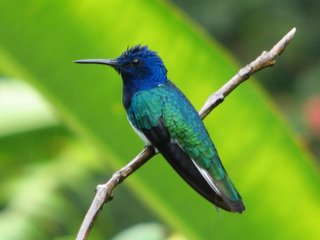 More than a month has passed since Michelle and I got married and went on our honeymoon trip to Trinidad & Tobago. Since then I've been meaning to post a report with details of the places we went, birds we saw, etc. But time has been in short supply (the usual lament), and until now updating this blog has taken a backseat to more pressing concerns.
More than a month has passed since Michelle and I got married and went on our honeymoon trip to Trinidad & Tobago. Since then I've been meaning to post a report with details of the places we went, birds we saw, etc. But time has been in short supply (the usual lament), and until now updating this blog has taken a backseat to more pressing concerns. It was a great trip, and I would recommend Trinidad & Tobago to anyone. We spent the first few days at the famous Asa Wright Nature Centre, located in the mountains of Trinidad's Northern Range. At Asa Wright we learned why they call it "rainforest." It rained. It drizzled. It rained some more. While we waited for the weather to improve we watched birds from the veranda, which overlooks a row of very busy feeding stations. Not a bad place for a birder to be stuck on a rainy day. I practiced using my new digital camera (a Canon Powershot S2) on the multitudes of hummingbirds, honeycreepers, and tanagers that are attracted to the centre's feeders and flowers. The above photo of a White-necked Jacobin was shot from the veranda while we sought shelter from the rain. Below is a view from the veranda.
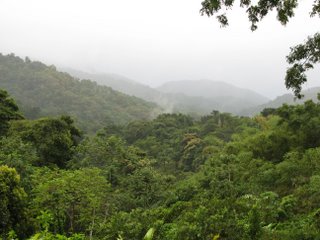 January is normally within the dry season, but this past January was unusually wet, with relentless monsoons that caused flooding at lower elevations. Fortunately there were occasional breaks between the heavy downpours.
January is normally within the dry season, but this past January was unusually wet, with relentless monsoons that caused flooding at lower elevations. Fortunately there were occasional breaks between the heavy downpours. An absolute must for any birder who visits Asa Wright is the hike to Dunstan Cave to see the Oilbirds. Fortunately for us the rain abated on the morning that we went, meaning we only got slightly soaked. Our guide told us to be alert for snakes, and sure enough I spotted a baby fer-de-lance on the trail. Snakes are cool, and I like finding the venemous ones. Here's a picture of our fearsome serpent.
 One of the things I love about travelling is those little encounters with the unexpected. Diurnal bats, for example. Prior to this trip I assumed that all bats were either nocturnal or crepuscular, so I was surprised to learn that some tropical species are active by day. It was mid-morning when we hiked to Dunstan Cave, but there were still bats flying around in the deep shade of the forest interior.
One of the things I love about travelling is those little encounters with the unexpected. Diurnal bats, for example. Prior to this trip I assumed that all bats were either nocturnal or crepuscular, so I was surprised to learn that some tropical species are active by day. It was mid-morning when we hiked to Dunstan Cave, but there were still bats flying around in the deep shade of the forest interior.I wasn't able to get a decent photo of an Oilbird - to lessen disturbance of the birds no flash photography is allowed inside the grotto where they roost. A stream flows through the cave, and we had to wade through the torrent to see them. Good thing Michelle and I wore rubber boots! By flashlight we could see the Oilbirds resting on ledges in the darkness. Some birds are just plain weird. Oilbirds are weird. They are nocturnal frugivorous troglodytes, and look like a cross between an owl and a nightjar (although they are closely related to neither). Not only do they look strange, but they make the most hideous racket when disturbed. Sounds like someone screeching and gagging at the same time.
On our way back to the nature centre our guide showed us another odd nocturnal species, the Common Potoo. It was sitting at the end of a branch pretending to be part of the tree.
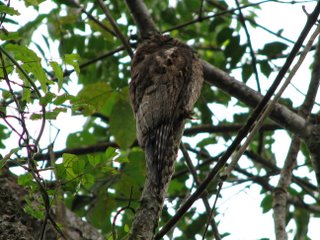 A trip to Trinidad wouldn't be complete without visiting Caroni Swamp to see the evening flight of Scarlet Ibises. Michelle and I were really looking forward to it (and eager to get away from the constant rain that was keeping us indoors most of the time). So we were not happy when the tour group left without us. Another couple of birders also got left behind, and together we complained to the person at the front desk, who was able to arrange alternate transportation for us. Eventually we caught up with the rest of the group. Once we got into the swamp it started to rain again, and we took another drenching. But despite the snafu and deluge we did get to see the ibises and have our complimentary rum punch.
A trip to Trinidad wouldn't be complete without visiting Caroni Swamp to see the evening flight of Scarlet Ibises. Michelle and I were really looking forward to it (and eager to get away from the constant rain that was keeping us indoors most of the time). So we were not happy when the tour group left without us. Another couple of birders also got left behind, and together we complained to the person at the front desk, who was able to arrange alternate transportation for us. Eventually we caught up with the rest of the group. Once we got into the swamp it started to rain again, and we took another drenching. But despite the snafu and deluge we did get to see the ibises and have our complimentary rum punch. The next day we went on a tour of Nariva Swamp, which is on the east side of the island. Finally a day without rain! Along the way we made stops to look at roadside raptors and a Yellow-rumped Cacique colony, visited the Aripo Agricultural Experiment Station to see grassland birds, and had a delicious picnic lunch at Manzanilla Beach. Our guide Rudal knew where to go and was very good at spotting birds for us. Before returning to Asa Wright we made a final stop at Wallerfield to see the Red-bellied Macaws return to their nightly roosts in the palms. Again there was the complimentary rum punch. We got back at about 8pm and were pleasantly surprised to find a late dinner still waiting for us. By the way, the food at Asa Wright is excellent.
The next day we went on a tour of Nariva Swamp, which is on the east side of the island. Finally a day without rain! Along the way we made stops to look at roadside raptors and a Yellow-rumped Cacique colony, visited the Aripo Agricultural Experiment Station to see grassland birds, and had a delicious picnic lunch at Manzanilla Beach. Our guide Rudal knew where to go and was very good at spotting birds for us. Before returning to Asa Wright we made a final stop at Wallerfield to see the Red-bellied Macaws return to their nightly roosts in the palms. Again there was the complimentary rum punch. We got back at about 8pm and were pleasantly surprised to find a late dinner still waiting for us. By the way, the food at Asa Wright is excellent.Male Green Honeycreeper at Asa Wright Nature Centre.
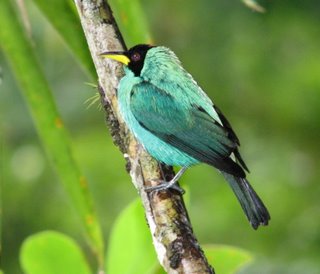 On the last morning of our stay at Asa Wright I had a magical birding experience. Michelle opted to sleep in, but I wanted to do some last-minute birding before our 9am departure for Tobago. I was up and ready to go at dawn. It wasn't raining for a change. Almost immediately I found a Ferruginous Pygmy-Owl calling from a cecropia near our room. While I was watching it a second owl flew in and they briefly copulated, then flew off together. I went up to the veranda to check out the action at the feeders, and was lucky enough to see Cinnamon Woodpecker and a male Barred Antshrike, birds that we had missed on previous days. Then I hurried down the trail in a last-ditch effort to find the elusive Bearded Bellbird.
On the last morning of our stay at Asa Wright I had a magical birding experience. Michelle opted to sleep in, but I wanted to do some last-minute birding before our 9am departure for Tobago. I was up and ready to go at dawn. It wasn't raining for a change. Almost immediately I found a Ferruginous Pygmy-Owl calling from a cecropia near our room. While I was watching it a second owl flew in and they briefly copulated, then flew off together. I went up to the veranda to check out the action at the feeders, and was lucky enough to see Cinnamon Woodpecker and a male Barred Antshrike, birds that we had missed on previous days. Then I hurried down the trail in a last-ditch effort to find the elusive Bearded Bellbird.Bearded Bellbird is the kind of bizarre species that birders travel to very wet remote jungles to see. The "beard" is a mass of wattles that dangle from the male's throat, looking sort of like a clump of stringy black Spaghetti. The male's call is a loud BONK, which sounds more like a hammer striking an anvil than a bell. I'd been hearing them since our arrival, but had been frustrated in my attempts to see one. On our final morning at Asa Wright there were several males calling back and forth to each other in the dense forest below the nature centre, and I cautiously approached them hoping to catch a glimpse of one. Less than 30 minutes into my search I was looking at a male Bearded Bellbird. Now I can die happy.
From Trinidad we flew to its sister island of Tobago. There we stayed at the Blue Waters Inn, which is on its own small bay at the east end of the island. Our room was right on the beach, and Michelle counted fifty paces from our door to the surf. The atmosphere was more relaxed, and we really enjoyed our time there. Tobago has fewer species than Trinidad, but the birding was excellent. Rufous-vented Chachalacas strolled the grounds, a Yellow-crowned Night-Heron had the beach staked out, and there were even birds inside the restaurant/bar – Ruddy Turnstones wandered around the tables looking for tidbits, and a Bananaquit kept trying to open the liquor bottles! There was also some good forest birding in the vicinity. This Rufous-tailed Jacamar sat for photographs along a nearby trail.
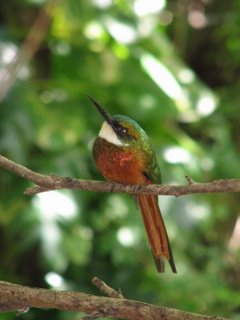 But the real avian highlight was our trip across the bay to Little Tobago Island, where we were able to get within mere feet of nesting seabirds! Here's Michelle looking into a burrow at the butt end of an Audubon's Shearwater and its egg.
But the real avian highlight was our trip across the bay to Little Tobago Island, where we were able to get within mere feet of nesting seabirds! Here's Michelle looking into a burrow at the butt end of an Audubon's Shearwater and its egg.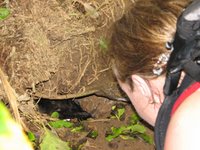 I’ve gone on many pelagic trips off both coasts hoping to see a tropicbird, but have never been so fortunate (Michelle has; last year she saw one while vacationing in the Virgin Islands). On Little Tobago Island my luck with tropicbirds finally changed. Not only did we see many Red-billed Tropicbirds (some of them sitting almost at our feet), we also enjoyed excellent views of an adult White-tailed Tropicbird that repeatedly circled one of the island’s little coves. This has to be the most graceful and elegantly plumaged of all seabirds.
I’ve gone on many pelagic trips off both coasts hoping to see a tropicbird, but have never been so fortunate (Michelle has; last year she saw one while vacationing in the Virgin Islands). On Little Tobago Island my luck with tropicbirds finally changed. Not only did we see many Red-billed Tropicbirds (some of them sitting almost at our feet), we also enjoyed excellent views of an adult White-tailed Tropicbird that repeatedly circled one of the island’s little coves. This has to be the most graceful and elegantly plumaged of all seabirds.Below is a pair of Red-billed Tropicbirds at their nest on Little Tobago Island; note the downy chick nestled between them.
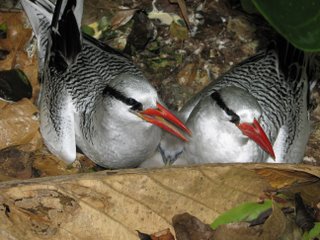 The reefs near Blue Waters Inn offer excellent snorkeling, so we did a little fish watching too. On one of our snorkeling trips we had a close encounter with a Hawksbill Turtle (very cool!). We also had less pleasant encounters with what are commonly known as "sea lice", or as our boat pilot called them, "sea ants." Of course they are neither lice nor ants, but tiny larval jellyfish that cause sudden burning pain when they come in contact with skin. We couldn't see them but definitely felt them. Fortunately the burning sensation goes away quickly and leaves no marks, but their stings did detract a little from the otherwise wondrous underwater experience.
The reefs near Blue Waters Inn offer excellent snorkeling, so we did a little fish watching too. On one of our snorkeling trips we had a close encounter with a Hawksbill Turtle (very cool!). We also had less pleasant encounters with what are commonly known as "sea lice", or as our boat pilot called them, "sea ants." Of course they are neither lice nor ants, but tiny larval jellyfish that cause sudden burning pain when they come in contact with skin. We couldn't see them but definitely felt them. Fortunately the burning sensation goes away quickly and leaves no marks, but their stings did detract a little from the otherwise wondrous underwater experience.Feeders at Blue Waters Inn attracted hordes of Bananaquits by day and swarms of nectar-feeding bats by night. Using my digital camera and flash I managed to get some photographs of the bats as they flew in to slurp at the feeders. Here is one of my better bat shots.
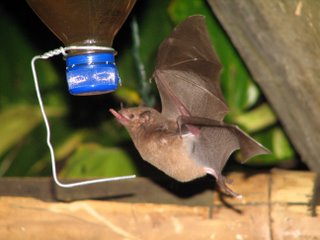
My final tally for the trip was 137 species, not bad considering that this was really our honeymoon, and birding was supposed to be secondary (Michelle has been very understanding of my bird obsession - at least now she knows what she's gotten herself into).


0 Comments:
Post a Comment
<< Home